Melaka(Malacca)
Negeri Bersejarah (Historical State)
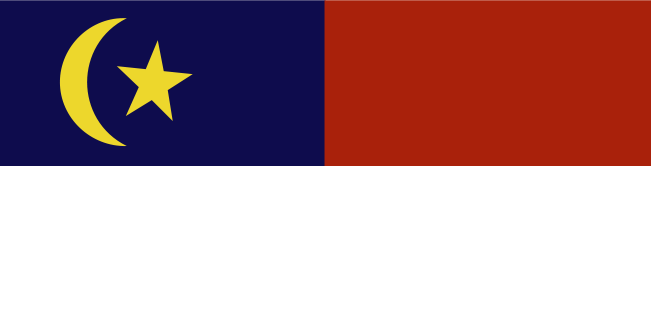
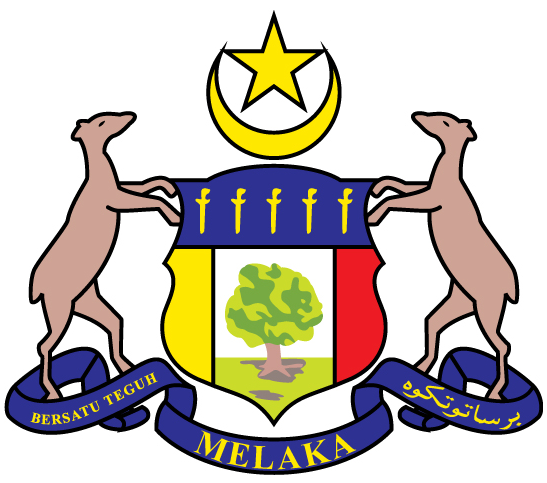
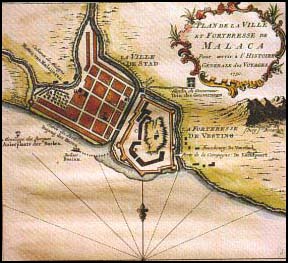 Historical Melaka(Malacca) is indeed the soul of the nation. It is here where we link our past to the present, on how we have grown and changed along the centuries. The highlight is the historic port city, also called Melaka. In the 14th century, Melaka was just a fishing village until it attracted Parameswara, a Hindu prince from Sumatra. He had fled Majapahit Empire in Sumatra and went to Temasik(Singapore) before finally settling in Melaka in 1396. Under Parameswara, Melaka soon became a favoured port for merchants resupplying their ships or waiting out the monsoons. Halfway between China and India, Melaka attracted merchants from all over the East. In 1405 Admiral Cheng Ho of China arrived in Melaka bearing gifts from the Ming emperor and protection from Siamese enemies. Chinese settlers followed and intermingled with the locals, married them and adopted Malay customs. They came to be known as the Peranakan or Straits Chinese. The husband is called Baba and the wife Nyonya and speaks the Baba Malay, a mix of Malay and Chinese Hokkien. Like the Chinese Peranakan, Indians traders from Panai, Tamil Nadu India also settled, married the locals and adopted Malay customs. These Indian peranakans are called Chitty and most are unable to communicate in Tamil fluently. By the time of Parameswara’s death in 1414, Melaka was already a bustling trading state. Islam was introduced here through traders from India. The third ruler of Melaka, Maharaja Mohammed Shah, converted to Islam, and his son, Mudzaffar Shah, took the title of sultan and made Islam the state religion. Soon the religion spread to most of the peninsula.
Historical Melaka(Malacca) is indeed the soul of the nation. It is here where we link our past to the present, on how we have grown and changed along the centuries. The highlight is the historic port city, also called Melaka. In the 14th century, Melaka was just a fishing village until it attracted Parameswara, a Hindu prince from Sumatra. He had fled Majapahit Empire in Sumatra and went to Temasik(Singapore) before finally settling in Melaka in 1396. Under Parameswara, Melaka soon became a favoured port for merchants resupplying their ships or waiting out the monsoons. Halfway between China and India, Melaka attracted merchants from all over the East. In 1405 Admiral Cheng Ho of China arrived in Melaka bearing gifts from the Ming emperor and protection from Siamese enemies. Chinese settlers followed and intermingled with the locals, married them and adopted Malay customs. They came to be known as the Peranakan or Straits Chinese. The husband is called Baba and the wife Nyonya and speaks the Baba Malay, a mix of Malay and Chinese Hokkien. Like the Chinese Peranakan, Indians traders from Panai, Tamil Nadu India also settled, married the locals and adopted Malay customs. These Indian peranakans are called Chitty and most are unable to communicate in Tamil fluently. By the time of Parameswara’s death in 1414, Melaka was already a bustling trading state. Islam was introduced here through traders from India. The third ruler of Melaka, Maharaja Mohammed Shah, converted to Islam, and his son, Mudzaffar Shah, took the title of sultan and made Islam the state religion. Soon the religion spread to most of the peninsula.
In 1509 the Portuguese arrived at Melaka seeking the wealth of the spice and China trades, but after an initially friendly reception, they were attacked by Melakans and some were captured. This prompted an outright assault by the Portuguese, and in 1511 Alfonso de Albuquerque took the city, forcing the Sultan to flee to Johor, where he re-established his kingdom. The period of Portuguese strength in the East was short-lived, as Melaka suffered harrying attacks from rulers of neighbouring Johor and Negeri Sembilan, as well as from the Islamic power of Aceh in Sumatra. Melaka passed into Dutch hands after an eight-month siege in 1641 and was ruled for about 150 years. In Melaka they built fine public buildings and churches, which remain the most solid reminders of European presence. When the French occupied Holland in 1795, the British, allies of the Dutch, temporarily took over administration of the Dutch colonies, which include Melaka. In 1824 Melaka was permanently ceded to the British. Melaka, together with Penang and Singapore, formed the Straits Settlements, the three British centres for later expansion into the peninsula. Melaka eventually decline in the wake of a rapidly growing Singapore and became a quiet backwater.

Sights – In the City of Melaka(Malacca) êêê > Go to Malaysia Map for Melaka City Map
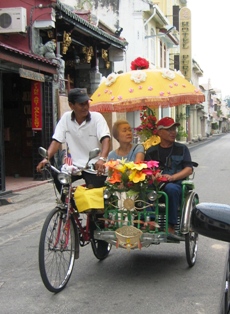 The old part of the city with most of the historical buildings and sites lies near the Melaka river mouth. The city’s unique personality draws from its mix of Peranakan shop houses, Portuguese and Dutch architecture, Victorian vestiges, Buddhist, Taoist and Indian temples and Islamic mosques. When you have had your fill of Melaka’s sights, food lovers can sample some of Malaysia’s best and unique cuisine here. From characteristic Chicken Rice Balls, Peranakan dishes to Portuguese cooking, the aromas in restaurants citywide are further testament to the cultural mosaic that makes Melaka such an intriguing port. Sadly though, some old buildings are sometimes torn down, or current ones being altered resulting in loss of old world charm. This is especially so for buildings in old Chinatown in Melaka. There was even a plan to build a revolving tower very close to the Dutch square until groundwork unearthed some Old Portuguese walls stopped work. Nevertheless, there is still much to see and experience here.
The old part of the city with most of the historical buildings and sites lies near the Melaka river mouth. The city’s unique personality draws from its mix of Peranakan shop houses, Portuguese and Dutch architecture, Victorian vestiges, Buddhist, Taoist and Indian temples and Islamic mosques. When you have had your fill of Melaka’s sights, food lovers can sample some of Malaysia’s best and unique cuisine here. From characteristic Chicken Rice Balls, Peranakan dishes to Portuguese cooking, the aromas in restaurants citywide are further testament to the cultural mosaic that makes Melaka such an intriguing port. Sadly though, some old buildings are sometimes torn down, or current ones being altered resulting in loss of old world charm. This is especially so for buildings in old Chinatown in Melaka. There was even a plan to build a revolving tower very close to the Dutch square until groundwork unearthed some Old Portuguese walls stopped work. Nevertheless, there is still much to see and experience here.
Old Melaka is a small town that is easy to navigate and compact enough to explore on foot, bicycle or on one of the gaudy looking trishaw (bicycle rickshaw). The older parts of Melaka are mainly on the eastern side of the river, particularly around Town Square, also known as Dutch Square. On the western side of the river lies Chinatown with old shops dating back to the 19th century.
Stadthuys & Christ Church Painted red, the Stadthuys was built between 1641 and 1660 and is believed to be the oldest Dutch building in the East. It features substantial solid doors and louvred windows; the port-red theme extends to the other building around the Town Square and the old clock tower. It is now the History & Ethnography Museum. Also within the Stadthuys is the Literature Museum. Stadthuys Admission RM2; 9am-6pm Sat-Thu. 9am-12.15pm & 2.45-6pm Friday. Christ Church in the Dutch square was built in 1753 by the Dutch. Its notable feature is the ceiling, whose beams, over 15m (16yd) long, were each made from a single tree. The handmade pews are original, dating back 200 years. Over the altar, there is a painting of the Last Supper on glazed tiles and on the floors are tombstones in Armenian script. The entrance is free but you may be politely asked to make a donation towards the upkeep of the church. Located at the dutch square is the Queen Victoria Diamond Jubilee fountain, completed in the year 1904.
St Paul’s Church It was built on top of Melaka Hill by a Portuguese nobleman Duarte Coelho in 1521 and was called the ‘Our Lady of the Hill’ before the Dutch renamed it St.Paul’s Church. The church was regularly visited by Basque priest St Francis Xavier. Following his death in China, the saint’s body was brought here to be buried. Nine months later it was transferred to Goa in India, where it remains today. In 1556 the church was enlarged to two storeys and a tower added to the front in 1590. The church was renamed following the Dutch takeover, but when the Dutch completed their own Christ Church at the base of the hill, it fell into disuse. The roofless church has been in ruins now for more that 150 years, but the setting is beautiful and in contains some interesting stone slabs inside. A marble statue of St Francis Xavier commemorates his interment here over 400 years ago. His statue was erected with his right arm missing, apparently to show that his body in Goa is still without the right arm. Back in 1614, the Pope had requested the right arm of St Francis to be severed from his corpse and sent to Rome. Although he had been dead for 62 years, blood was said to have gushed out of the arm. Immediately after St Francis was canonised a saint in 1622, what remained of the right arm in Rome was merely a skeleton, but the body in Goa remains intact except for the missing right arm. In 1952, the Bishop of Macau decided to put up a statue in front of St Paul's Church. A marble statue was ordered from Italy and was sculpted by the famous Italian sculptor, G Toni, and was ready for the fourth centenary celebrations on March 22, 1953.
A’Famosa Down the hill from St Paul’s Church is the Porta de Santiago, the main gate of what was once the Portuguese fortress of A’Famosa, originally constructed by Alfonso de Albuquergue, the conqueror of Melaka, in 1512. Most of the fortress was destroyed by the British and the gate was saved from destruction by Stamford Raffles. West of Porta de Santiago is the Muzium Rakyat or People’s Museum, which highlights Malaysian society and culture. Entrance fee is RM2.
Muzium Budaya The Cultural Museum is a wooden replica of a Melaka sultan’s palace. This building is based on description from the Malay Annals of the original 15th-century palace, built entirely without nails. The exhibits here concentrate on traditional Melakan Culture, including textiles, games, weaponry, musical instruments and a diorama of the sultan’s court. The museum also holds the Terengganu Stone with its early 14th century Arabic and Malay inscriptions, the first evidence of Islam on the peninsula. Tel. No. : 606-282 7464, Operating hours : 9.00am-6.00pm, Entrance fee : Adult/Child, RM2.00/RM0.50, Closed on Tuesdays.
Close by, housed in a British villa dating from 1911, the Proclamation of Independence Memorial is a museum charting the history of Malaysia’s progression to independence. Free admission. 9am-6pm Sat-Thu. 9am-12pm & 3pm-6pm Fri.
Boat Trips Boats can be hired from the quay behind the tourist office on Jln Kota, near the Dutch square, for a river tour of Sungai Melaka. It takes you to Kampung Morten, where Villa Sentosa is located, and pass river warehouses. There are lots of huge monitor lizards around the warehouses and river banks. The commentary may not be all that informative and the river not the cleanest but it is an interesting short ride. Fee is RM8; 45 minutes ride. Minimum 6 people.
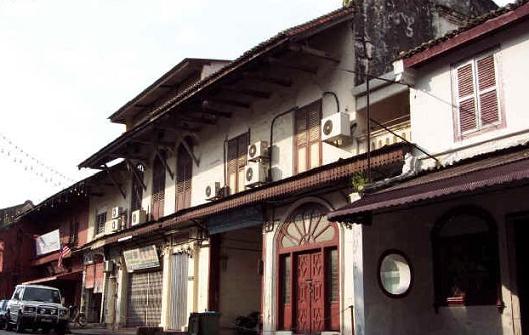 Chinatown Located at the west of the Melaka river is a few rows of old shops that make up Chinatown. This is one of the best Chinatowns in Malaysia. It is mainly located on 3 roads. The first is Jalan Tun Tan Cheng Lock(formerly Heeren St.,& Holland St to the Chinese). It was also nicknamed Millionaires' Row as most of the Chinese millionaires of the pioneering period lived on this street. The second road is Jalan Hang Jebat(formerly Jonkers St.) and Jalan Tokong(Temple Street). Shop houses date back to the 19th century, with many occupied now by antique shops, restaurants and hotels. Many of them have an opening or a courtyard in the middle of the rather long shops to allow light in and rain water to be collected in a well. While walking along this street, look up at the carved lintels, cornices and other
Chinatown Located at the west of the Melaka river is a few rows of old shops that make up Chinatown. This is one of the best Chinatowns in Malaysia. It is mainly located on 3 roads. The first is Jalan Tun Tan Cheng Lock(formerly Heeren St.,& Holland St to the Chinese). It was also nicknamed Millionaires' Row as most of the Chinese millionaires of the pioneering period lived on this street. The second road is Jalan Hang Jebat(formerly Jonkers St.) and Jalan Tokong(Temple Street). Shop houses date back to the 19th century, with many occupied now by antique shops, restaurants and hotels. Many of them have an opening or a courtyard in the middle of the rather long shops to allow light in and rain water to be collected in a well. While walking along this street, look up at the carved lintels, cornices and other 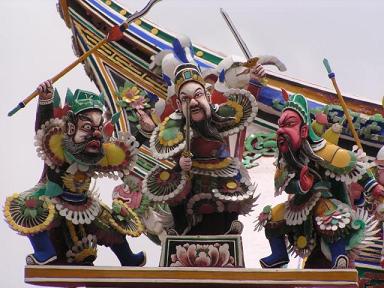 architectural flourishes. Apart of the interesting antique shops and restaurants, other points of interest are the Baba-Nyonya Heritage Museum, Baba House hotel, Eng Choon Association on Jalan Tun Tan Cheng Lock, Leong San Thong on Jalan Hang Lekir, Hang Kasturi’s Tomb(Malay warrior), Guanyin Temple on Jalan Hang Jebat and Wah Teck Kiong Temple, Guangfu Temple, Wah Aik shoe maker (One of the few remaining makers in the world for shoes of bound feet), the beautiful Cheng Hoon Teng Temple, Kampung Kling Mosque, the Chitty Sri PoyyathaVinayagar Moorthi Temple and Sanduo Temple on Tokong Street. Another malay warrior's tombstone, Hang Jebat's mausoleum is located in Chinatown, at Lorong Tukang Kuli. Jalan Hang Jebat is closed to cars during Friday and Saturday evenings and becomes a huge pedestrian walkway.
architectural flourishes. Apart of the interesting antique shops and restaurants, other points of interest are the Baba-Nyonya Heritage Museum, Baba House hotel, Eng Choon Association on Jalan Tun Tan Cheng Lock, Leong San Thong on Jalan Hang Lekir, Hang Kasturi’s Tomb(Malay warrior), Guanyin Temple on Jalan Hang Jebat and Wah Teck Kiong Temple, Guangfu Temple, Wah Aik shoe maker (One of the few remaining makers in the world for shoes of bound feet), the beautiful Cheng Hoon Teng Temple, Kampung Kling Mosque, the Chitty Sri PoyyathaVinayagar Moorthi Temple and Sanduo Temple on Tokong Street. Another malay warrior's tombstone, Hang Jebat's mausoleum is located in Chinatown, at Lorong Tukang Kuli. Jalan Hang Jebat is closed to cars during Friday and Saturday evenings and becomes a huge pedestrian walkway.
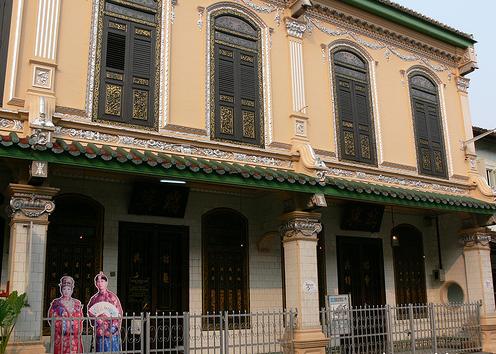 Baba-Nyonya Heritage Museum This museum, with a guided tour, is worth a visit as it highlights the cultural and artistic uniqueness of a traditional Peranakan townhouse in Chinatown. It may be a little overdone as it has a rich collection of items, but it is generally based on a typical 19th-century rich Baba-Nyonya residence. It contains Chinese hardwoods fashioned in a mixture of Chinese, Victorian and Dutch designs with mother of pearl inlay. There are also displays of ‘Nyonya ware’, multicoloured ceramic designs from Jiangxi and Guangdong provinces in China, made specifically for Straits Chinese. Nyonya ceramics and tile works are usually a blend of pink, yellow, dark blue and green colours. Tel ; 606 283 1273, Jln Tun Tan Cheng Lock, Adult/Child RM8/4, 10am-12.30pm & 2pm-4.30pm. Closed on Tuesdays.
Baba-Nyonya Heritage Museum This museum, with a guided tour, is worth a visit as it highlights the cultural and artistic uniqueness of a traditional Peranakan townhouse in Chinatown. It may be a little overdone as it has a rich collection of items, but it is generally based on a typical 19th-century rich Baba-Nyonya residence. It contains Chinese hardwoods fashioned in a mixture of Chinese, Victorian and Dutch designs with mother of pearl inlay. There are also displays of ‘Nyonya ware’, multicoloured ceramic designs from Jiangxi and Guangdong provinces in China, made specifically for Straits Chinese. Nyonya ceramics and tile works are usually a blend of pink, yellow, dark blue and green colours. Tel ; 606 283 1273, Jln Tun Tan Cheng Lock, Adult/Child RM8/4, 10am-12.30pm & 2pm-4.30pm. Closed on Tuesdays.
Cheng Hoon Teng Temple Cheng Hoon Teng Main Temple (The Temple of Green Cloud) is dedicated to the Goddess of Mercy. Dating back to 1646, it is the oldest Chinese temple in Malaysia, with all building materials imported from China, along with the artisans involved in its construction. It is still frequented by many worshipers as it remains a venerable and sacred site. It was restored recently and the restoration won a Unesco Asia-Pacific Heritage Conservation Award 2002 for “Award of Merit”. A total of USD 400,000 was spent. Entrance is Free. It is located at Chinatown, 25 Temple Street Jalan Tokong.
St. Peter’s Church This is the oldest functioning Catholic Church in Malaysia. It was built in 1710 by descendants of early Portuguese settlers. The church has stained-glass windows and a bell cast in Goa(India) in 1608. It is still a functioning church and open only to worshippers during mass. However, you can walk the grounds of this newly painted church.
Bukit Cina & Puteri Hang Li Poh well In the middle of the 15th century the sultan of Melaka’s ambassador to China returned with the Ming emperor’s daughter to wed the sultan and thus seal relations between the two countries. She came, along with 500 handmaidens, and Bukit Cina was established as their residence. It now joints another hill forming one of the largest Chinese cemetery in the world outside China. Some ornate graves date back to the Ming dynasty. The hill is somewhat in a deplorable state due to lack of maintenance but nevertheless has significant historical value. At the foot of the hill is the Poh San Teng Temple built in 1795. It contains Taoist entity Dabo Gong, and Guanyin. To the right of the temple is the Hang Li Poh well, a 15th century well built by Sultan Mansor Shah for his Chinese wife, Princess Hang Li Poh.
Maritime Museum & Naval Museum Located at the river mouth, 300metres further down the Dutch square, is the replica of the Flora de la Mar, a Portuguese ship that sank off the coast of Melaka while trying to transport Malaysian treasures back to Europe. It houses the Maritime Museum. The exhibits have detailed descriptions of Melaka’s history, as well as ship models, dioramas and an interesting map room featuring charts dating back to Portuguese times.
The naval museum is across the street. Salvaged remnants from the Diana, sunk off Melaka in 1817 while voyaging from Guangzhou to Madras, are displayed, plus a host of discolouring photos on Malaysia’s maritime past.
Portuguese square About 3km east of the city centre on the coast is a relatively new area known as Medan Portugis or Portuguese Square. The small settlement is home to around 2,000 descendants of the Portuguese who arrived here in Melaka in 1511. Upon arrival, they built settlements and married the locals. Known as Eurasians, their language is Christang, an old form of Portuguese. The Eurasians are predominantly Catholic and now govern by Regedor Peter Thomas Gomes. The settlement is built up of mainly modern terrace housing and the square itself pretty plain and says nothing of Portuguese influence in terms of architecture, except that the layout is suppose to follow after a typical Mercado. However, look for the house of Nicholas Loboo, which was restored by the Melaka Museum Corporation, and showcases traditional Portuguese house in Malacca. There are many food stalls located at the seaside and the evening sea breeze is lovely. The Portuguese food at Restoran de Lisbon is tastier but unfortunately, it does not offer seaside seating. There is a rather small single room museum next to a souvenir shop located at the Mercado with some explanations and pictures of the settlements and some old items. What are interesting about this place are the people, their language, and the delicious food. You can also try to arrange for a display of traditional Portuguese dance by calling Papa Joe, Mobile Contact Number: 019 6284758. The settlement is located in Ujong Pasir, Melaka.
Getting there
By car : Follow Jalan Parameswara until you reached the turning to Jalan Bukit Senjuang. You will see the St. John’s Fort on your right. Just a few metres up ahead, there’s a small turning to Jalan Hujung Pasir. The turning is not that easy to spot and often people have to make a round trip to get another try at it.
By bus : Take Town bus no.17 from the local bus station.
Fort of St John The fort was originally a Portuguese chapel dedicated to St John the Baptist until the Dutch rebuilt it in the 18th century. It stands on a hilltop to the east of town just before the turn-off to Portuguese square – head east along Jln Parameswara, then turn left into Jalan Bukit Senjuang. A few walls and cannon emplacements of the fort remains, but there are fine views from the hilltop.
Masjid Tranquerah This is a Sumatran designed 150 year old mosque. In its graveyard is the tomb of Sultan Hussein of Johor, who in 1819 signed over the island of Singapore to Stamford Raffles. Take bus No.18 from Melaka’s local bus station.
Villa Sentosa This is an old kampung house dating to the 1920s on the Melaka River in Kampung Morten. It is worth the visit as not only will you see a genuine Malay kampung house but will also wander through a Malay village setting. A member of the family will show you around the house, accessed via a bridge, and show you their many collections of old items. 606 282 3988; www.travel.to/villasentosa; entry by donation; 9am-1pm & 2-5pm.
Kampung Chitty The Chitty are a distinctive group of Tamil people found mainly in Melaka, who are also known as the Indian Peranakans. Historical records stated that the Tamil traders from Panai in Tamil Nadu settled down in Melaka during the sovereignty of the Sultanate of Melaka. Like the Peranakans, the later settled down and freely intermingled with the local Malays and Chinese settlers. However, with the fall of the Melaka Sultanate after 1511, the Chitty eventually lost touch with their native land. Like the Peranakans, the Chitty speak a Malay patois, which is mixed with many Tamil loan words. Many of the Chitty are unable to communicate in Tamil fluently. The Chitty population is around 2000 and the traditional Chitty settlement is located at Kampung Tujuh along Jalan Gajah Barang, about a kilometre northwest of Chinatown. The houses here are of traditional Malay style. Other interesting things to see include old Chitty temples and a small museum.
Festivals and events
Festa San Pedro
If you are Melaka in late June, you will have the chance to witness Fiesta San Pedro, a delightful cultural event celebrated here to commemorate the birthday of the patron saint of fishermen, San Pedro. Celebrations take place at St Peter’s Church and normally include a float procession from the Porta de Santiago to Portuguese square. There are cultural Portuguese dances and fishing boats, which are colorfully decorated for the festival, are blessed and prayers offered for a better season.
Festa San Juan
Festa San Juan is celebrated in late June just before the Festa San Pedro. It is celebrated at the chapel on top of St John’s hill by the Eurasian community.
Dragon Boat Festival
This Chinese festival of Dragon Boat races commemorates the death by drowning of 3rd-century BC Chinese poet and statesman Qu Yuan. Held in the months of June and July, race details can be obtained from the Melaka Dragon Boat Association. Tel : 281 5649
Festa Santa Cruz
This festival is celebrated in mid September by Catholics, and the candlelight procession finishes at Malim Chapel.
Places to Stay
Melaka Hotels
Title: Melaka Hotels
URL: http://www.hoteltravel.com/malaysia/melaka/hotels.htm
Most are located at the Taman Melaka Raya on the reclaimed land south of Jalan Taman Melaka Raya.
Samudra Inn Tel: (606) 282 7441, Price RM10-RM20
Travelers’ Lodge Tel : (606) 226 5709, Price RM16-RM35
Eastern Heritage Guest House Tel: (606) 283 3026, Price RM8-RM20
Malacca Town Holiday Lodge 1 Tel: (606) 284 8830, Price RM15-18
Malacca Town Holiday Lodge 2 Tel : (606) 284 6905, Price RM16-27
Shirah’s Guest House Tel : (606) 286 1041, Price RM9-RM60
Kancil Guest House Tel : (606) 281 4044, Price RM12-RM30
Hollitel Tel: (606) 286 0607, Price RM55-RM70
Hinley Hotel Tel: (606) 283 6554, Price RM40-RM50
Melaka Arasma Belia Youth Hostel Tel: (606) 282 7915, Price RM10-RM15
Chong Hoe Hotel Tel: (606) 282 6102, Price RM22-RM40
Ng Fook Hotel Tel:(606) 282 8055, Price RM29-RM37
May Chiang Hotel Tel:(606) 282101, Price RM40
Mansor Hotel Tel:(606)283 7529, Price RM25
Sunny’s Inn Tel:(606) 227 5446, Price RM20-RM35
Baba House(Chinatown), Tel :(606)281 1216, Price RM85-RM95
Mimosa Hotel(Chinatown), Tel :(606) 282 1113, Price RM100
Century Mahkota Hotel, on reclaimed land, south of Mahkota Parade Tel: (606) 281 2828, Price RM178 – RM200
Hotel Puri (Chinatown), www.hotelpuri.com, Tel :(606)282 5588, Price RM110
Hotel Orkid, Tel :(606) 282 5555, Price RM99
Heeren House, Tel: (606) 281 4241, Price RM139
Emperor Hotel Tel :(606) 284 0777, Price RM250
Renaissance Melaka Hotel Tel :(606) 284 8888, price RM400
City Bayview Hotel Tel : (606) 283 9888, price RM318
Seri Costa Hotel Tel : (606) 281 6666, price RM220
Hotel Equatorial Tel : (606) 282 8333, price RM380 – RM410
Hotel Grand Continental Tel:(606) 284 0088, price RM200
Getting there
By Car : Melaka is 144km from Kuala Lumpur which is about 2 hours drive by car. It is 224km from Johor Bahru. From the north-south highway, turn of when you see the Melaka sign. To get to Melaka town, you need to drive pass Ayer Keroh town.
By Bus : Buses from major city and towns all over Malaysia will stop at the Express bus station at Kampung Morten. From Singapore, buses to Melaka can be booked from Lavender St. bus station or from an agent operating out of the Lavender MRT station.
By Train :Trains stop at Tampin, 38km north of Melaka town, on the main KL to Singapore line. A taxi ride to Melaka town is required after that.
Sights - Melaka’s other attraction
Ayer Keroh There are a few places of note here which include the Melaka Zoo(adult/child RM4/2), where the small collection of animals include Malayan Sun Bears, Asian elephants and the rare Sumatran Rhinos. The Crocodile Park (Adult/Child RM5/3) on the other side of the highway has over 200 of the reptiles. Further north along the main road is the Hutan Rekreasi Air Keroh, a recreational forest which is part secondary jungle and part landscaped park with paved trails, a 250m canopy walk, picnic areas and a forestry museum. Just a short distance away is the Taman Mini Malaysia/Asean (Adult/Child RM4/2) which showcases the traditional houses of all 13 Malaysian states, as well as neighbouring countries. 2km away is the Butterfly & Reptile Sanctuary (Adult/Child RM4/2)
Pulau Besar Pulau Besar is a small island located south of Melaka. It is popular with the locals for a weekend getaway and has clean white sand beaches. The water is a little clearer than on the mainland and has jungle greenery. There is one Pandanusa Resort located on the island. Tel : (606) 281 8007, Price RM99-RM129. Located only 5km away, it can be reached by boat from the jetty behind jln Kota in Melaka. Take the no.2 local bus from Melaka.
Tanjung Bidara This is a well known getaway for the locals eventhough the water is not pristine clear or the sand powdery white, like those in the East Coast islands. It is a convenient getaway for many who come just to relax at the beach or beach resorts or engage in fishing, swimming, sun bathing or water sports. It is best visited during weekdays and non holiday periods to avoid crowds. The main stretch of beach is at Tanjung Bidara Beach Resort. Tel (606) 384 2990, Price RM80-RM200. The other resort is the Samudera Bidara Resort. Tel (606) 384 7587, price RM60-RM80. Bus no. 42 and 47 from Melaka go to Masjid Tanah, where a taxi ride is required to reach the resorts.
Homestays in Melaka
Stay in a traditional Malay home instead of a hotel and get a feel of the kampung(village life). Please see homestay link.
Tourist Information Center Jalan Kota
Jalan Kota, 75000 Melaka
Tel: (606) 281 4803 / (606) 283 6538
Tourist Information Center Ayer Keroh
Lebuh Ayer Keroh, 75450 Melaka
Tel: (606) 293 3913
homepage > Melaka
| 2009 Events
Interesting Links on Melaka
http://www.tourism-melaka.com/
ANNUAL EVENTS (ALL DATES ARE TENTATIVE) For more information and exact timing, kindly contact: Tourism Promotion DivisionMelaka Chief Minister Department Tkt. 12, Graha Maju Jalan Graha Maju 75300 Melaka Tel: +606-288 2923 Fax: +606-288 2951 Tol Free: 1800-88-9483 Ikan Bakar Carnival, Perkampungan Ikan Bakar, Terapung Umbai
Fiesta San Juang, Portuguese Settlement
Fiesta San Pedro, Portuguese Settlement
Feast of St. Peter, St. Peter’s Church
Dragon Boat Race, Straits of Melaka
Malaysia Independence Patriotic Concert, Hang Jebat Stadium
Kite Flying Festival, Taman Kota Laksamana
Dutch Week, Stadhuys
Melaka International Songket and Batik Exhibition, Melaka International Trade Centre
Feast of Santa Cruz, St. Peter’s Church
Melaka International Tourism Show
Melaka International Consumer Fair 2007, Melaka International Trade Centre
Asian Aborigines Cultural Performances, D’Paradise, Tropical Fruits World & Aborigines Village
|
|||||||||||||||||||||||||||

